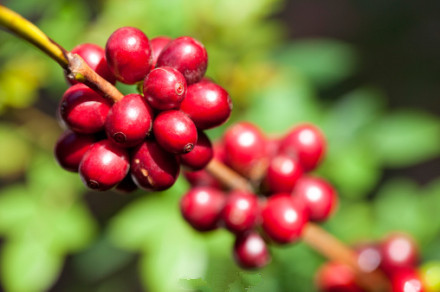Basic knowledge of Fine Coffee growth knowledge of Coffee trees
Coffee is a kind of drink, which gives the public the impression that it is black, bitter, sleepless and excited. The coffee beans we see in the coffee shop are tea-brown, which belongs to roasted coffee beans, while the color of the coffee liquid is amber. Coffee comes from coffee beans, which are harvested and processed from the fruit of trees.

The growth habits of coffee:
Coffee trees belong to the evergreen family of Akanaceae. They are tropical plants that are not cold. Most of them are planted in areas with elevations of 300,400m, and also in highlands with elevations of 2000-2500 meters. But those who plant on slopes above 1500 meters above sea level have better quality. Coffee trees are most suitable for growing in an environment where the average temperature is about 20 degrees Celsius, annual precipitation is 1500-2000 mm, soil permeability is strong, and sunshine is suitable. Coffee is afraid of Frosts Descent and the cold winter, and must not be planted in the highlands where frost falls. Generally speaking, wild coffee trees can grow to about 8 meters. They are planted at home. In order to protect the quality of coffee beans, facilitate management and harvest, the height is cut to 2 meters. Coffee beans begin to bear fruit 3-5 years after sowing, and 5-20 years is the harvest period. A coffee tree can produce about 3-5 kilograms of coffee cherries per year.
Distribution of coffee:
Coffee trees grow in national gardens in tropical or subtropical regions with the equator as the center and between latitudes 25 degrees south and north, called the coffee belt. At present, coffee is produced in more than 60 countries, widely distributed in South America, Central America, the West Indies, Asia, Africa, Arabia, the South Pacific and Oceania. In terms of production, Brazil, which accounts for the largest output in the world, accounts for about 30%; the second is Central and South America, which is centered on Colombia (10%), accounting for 60%; followed by Africa and Arabia, accounting for about 30%; the remaining 10% are distributed in Asia and most islands.
Important Notice :
前街咖啡 FrontStreet Coffee has moved to new addredd:
FrontStreet Coffee Address: 315,Donghua East Road,GuangZhou
Tel:020 38364473
- Prev

The birth process of boutique coffee
A good cup of coffee comes from small coffee beans, after a long time and many elaborate craftsmanship, and integrated into the efforts of countless people to achieve, it can be said that cups are not easy to come by. There are seven decisive factors for the quality of a cup of coffee. The first three depend on the variety of the farmer who grows the coffee beans, the origin of the coffee, and the method of growing the coffee, which is called determining the quality of the coffee.
- Next

High-quality coffee learns the growth process of coffee beans
Generally speaking, it is generally accepted that coffee was first found in Abyssinia, which is now Ethiopia. According to rumors, an Abyssinian shepherd found that the goat he was raising began to dance after eating some bright red fruit and leaves. Among the facts discovered by Kaldi, some monks can watch in order to make a late-night prayer meeting.
Related
- Beginners will see the "Coffee pull flower" guide!
- What is the difference between ice blog purified milk and ordinary milk coffee?
- Why is the Philippines the largest producer of crops in Liberia?
- For coffee extraction, should the fine powder be retained?
- How does extracted espresso fill pressed powder? How much strength does it take to press the powder?
- How to make jasmine cold extract coffee? Is the jasmine + latte good?
- Will this little toy really make the coffee taste better? How does Lily Drip affect coffee extraction?
- Will the action of slapping the filter cup also affect coffee extraction?
- What's the difference between powder-to-water ratio and powder-to-liquid ratio?
- What is the Ethiopian local species? What does it have to do with Heirloom native species?

